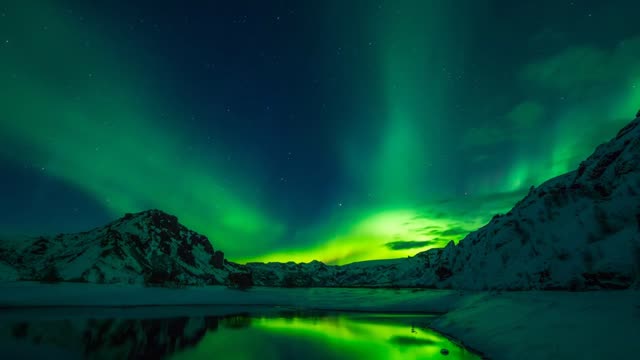Premium Only Content

An aurora[a] (plural: auroras or aurorae),[b] also commonly known as the polar lights,[c] is a natural light display in Earth's sky, predominantly seen in high-latitude regions (around the Arctic and Antarctic). Auroras display dynamic patterns of brilliant lights that appear as curtains, rays, spirals, or dynamic flickers covering the entire sky.[3]
Auroras are the result of disturbances in the magnetosphere caused by the solar wind. Major disturbances result from enhancements in the speed of the solar wind from coronal holes and coronal mass ejections. These disturbances alter the trajectories of charged particles in the magnetospheric plasma. These particles, mainly electrons and protons, precipitate into the upper atmosphere (thermosphere/exosphere). The resulting ionization and excitation of atmospheric constituents emit light of varying colour and complexity. The form of the aurora, occurring within bands around both polar regions, is also dependent on the amount of acceleration imparted to the precipitating particles.
Most of the planets in the Solar System, some natural satellites, brown dwarfs, and even comets also host auroras.
#aurora #auroras #northpole #southpole
The word "aurora" is derived from the name of the Roman goddess of the dawn, Aurora, who travelled from east to west announcing the coming of the sun.[4] Ancient Greek poets used the corresponding name Eos metaphorically to refer to dawn, often mentioning its play of colors across the otherwise dark sky (e.g., "rosy-fingered dawn").[5]
The words "borealis" and "australis" are derived from the names of the ancient gods of the north wind (Boreas) and the south wind (Auster).
Most auroras occur in a band known as the "auroral zone",[6] which is typically 3° to 6° wide in latitude and between 10° and 20° from the geomagnetic poles at all local times (or longitudes), most clearly seen at night against a dark sky. A region that currently displays an aurora is called the "auroral oval", a band displaced by the solar wind towards the night side of Earth.[7] Early evidence for a geomagnetic connection comes from the statistics of auroral observations. Elias Loomis (1860),[8] and later Hermann Fritz (1881)[9] and Sophus Tromholt (1881)[10] in more detail, established that the aurora appeared mainly in the auroral zone.
In northern latitudes, the effect is known as the aurora borealis or the northern lights. The former term was coined by Galileo in 1619, from the Roman goddess of the dawn and the Greek name for the north wind.[11][12] The southern counterpart, the aurora australis or the southern lights, has features almost identical to the aurora borealis and changes simultaneously with changes in the northern auroral zone.[13] The aurora australis is visible from high southern latitudes in Antarctica, Chile, Argentina, South Africa, New Zealand and Australia. The aurora borealis is visible from being close to the center of the Arctic Circle such as Alaska, the Canadian Territories, Iceland, Greenland, Norway, Sweden, Finland and Russia. On rare occasions the aurora borealis can be seen further south, for example in Estonia, Latvia, Lithuania, Scotland, Ireland, Denmark, and the northern part of the contiguous United States.
A geomagnetic storm causes the auroral ovals (north and south) to expand, bringing the aurora to lower latitudes. The instantaneous distribution of auroras ("auroral oval")[6] is slightly different, being centered about 3–5° nightward of the magnetic pole, so that auroral arcs reach furthest toward the equator when the magnetic pole in question is in between the observer and the Sun. The aurora can be seen best at this time, which is called magnetic midnight.
Auroras seen within the auroral oval may be directly overhead, but from farther away, they illuminate the poleward horizon as a greenish glow, or sometimes a faint red, as if the Sun were rising from an unusual direction. Auroras also occur poleward of the auroral zone as either diffuse patches or arcs,[14] which can be subvisual.
-
 LIVE
LIVE
FusedAegisTV
3 hours agoRumble Smackdown! #001 Street Fighter 6 $500 Online Tournament
83 watching -
 LIVE
LIVE
Major League Fishing
3 days agoLIVE! - MLF Bass Pro Tour: REDCREST - Day 2
231 watching -
 1:08:28
1:08:28
Twins Pod
9 hours agoConservative Latina FIRECRACKER Running For CONGRESS! | Twins Pod - Episode 59 - Valentina Gomez
40.6K11 -
 1:07:56
1:07:56
Jeff Ahern
2 hours ago $1.00 earnedFriday Freak out with Jeff Ahern (1pm Pacific)
16.6K -
 2:11:58
2:11:58
The Quartering
5 hours agoTrump's Job Market EXPLODES, Bill Burr Runs, Matt Walsh Triggers , Leftist Attacks My Company
179K94 -
 1:06:15
1:06:15
Sean Unpaved
6 hours agoColorado Set To Host NFL Showcase, Last Final Four Predictions, & Bracket Challenge Update!
59.4K2 -
 1:23:40
1:23:40
Ben Shapiro
6 hours agoEp. 2173 - FALLOUT: Stock Market Drops, Trump Pushes On
82K79 -
 58:57
58:57
Crypto Power Hour
10 hours ago $0.91 earnedKnow Your Coins, ‘In Crypto We Trust |EP10
23.9K3 -
 2:06:49
2:06:49
Tim Pool
7 hours agoHas Welfare DESTROYED US Culture & The Family? | The Culture War with Tim Pool
181K208 -
 1:55:37
1:55:37
Steven Crowder
8 hours ago🔴 The Friday Show: Fat Pride is Over, California Sucks, and So Does Springsteen (ft. Vince)
416K305